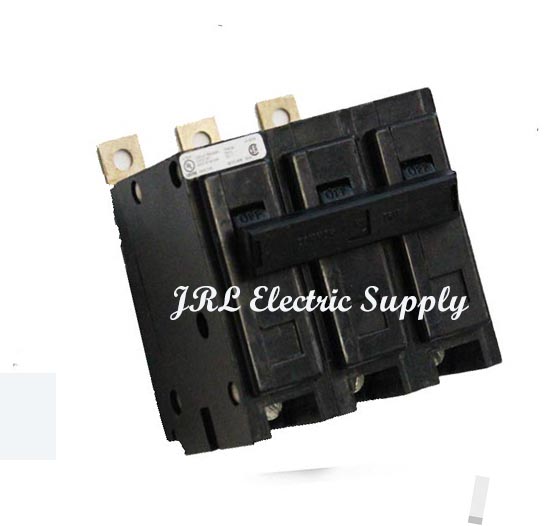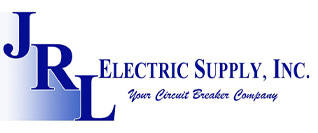
BAB Circuit Breakers are manufactured in 1, 2 and 3 Poles. They have an interrupting rating of 10,000 @ 240 Volt. These Bolt-on Circuit Breakers were originally manufactured by Westinghouse. They were made by Cutler Hammer also and now by Eaton. They are also called type BA Circuit Breakers.
BAB Circuit Breakers originally had only one handle only. The improved design and function made this change to three handles and a Plastic tie bar so the 2 and 3 poles would have a common trip on 2 and 3 poles. They are manufactured by Eaton and will still fit into Westinghouse and Cutler Hammer Panelboards,
Specifications
| AIC RATING | 10,000 @ 240 Volt |
|---|---|
| AMPERAGE | 40 |
| CONDITION | New |
| MANUFACTURE | Cutler Hammer |
| MANUFACTURE PART# | BABxxxx BAB first number is poles and last 3 are the amperage |
| MODEL TYPE | BAB |
| MOUNTING TYPE | Bolt-on |
| PART# | BAB1040 |
| POLES | 1, 2 and 3 |
| VOLTAGE | 120/240 Volt |
Do you need the manufactures Catalog Page for BAB Circuit Breakers? Click Here
Where can I purchase BAB Series Circuit Breakers?
Click Here for a link to purchase Circuit Breakers from a knowledgeable company that has specialized in Circuit Breakers since 1985
Click Here for BAB 2 Poles
Click Here for BAB 3 Poles
Great Information just for you from Wikipedia
What is a Circuit Breaker?
A circuit breaker is an electrical safety device designed to protect an electrical circuit from damage caused by an overcurrent or short circuit. Its basic function is to interrupt current flow to protect equipment and to prevent the risk of fire. Unlike a fuse, which operates once and then must be replaced, a circuit breaker can be reset (either manually or automatically) to resume normal operation.
Circuit breakers are made in varying sizes, from small devices that protect low-current circuits or individual household appliances, to large switchgear designed to protect high voltage circuits feeding an entire city. The generic function of a circuit breaker, or fuse, as an automatic means of removing power from a faulty system, is often abbreviated as OCPD (Over Current Protection Device).
What are the Circuit breaker Types
Low-voltage
Low-voltage (less than 1,000 VAC) types are common in domestic, commercial and industrial application, and include:
- Miniature circuit breaker (MCB)—rated current up to 125 A. Trip characteristics normally not adjustable. Thermal or thermal-magnetic operation. Breakers illustrated above are in this category.
- Molded Case Circuit Breaker (MCCB)—rated current up to 1,600 A. Thermal or thermal-magnetic operation. Trip current may be adjustable in larger ratings.
- Low-voltage power circuit breakers can be mounted in multi-tiers in low-voltage switchboards or switchgear cabinets.
The characteristics of low-voltage circuit breakers are given by international standards such as IEC 947. These circuit breakers are often installed in draw-out enclosures that allow removal and interchange without dismantling the switchgear.
Large low-voltage molded case and power circuit breakers may have electric motor operators so they can open and close under remote control. These may form part of an automatic transfer switch system for standby power.
Low-voltage circuit breakers are also made for direct-current (DC) applications, such as DC for subway lines. Direct current requires special breakers because the arc is continuous—unlike an AC arc, which tends to go out on each half cycle, direct current circuit breaker has blow-out coils that generate a magnetic field that rapidly stretches the arc. Small circuit breakers are either installed directly in equipment, or are arranged in a breaker panel.
Inside a miniature circuit breaker
The DIN rail-mounted thermal-magnetic miniature circuit breaker is the most common style in modern domestic consumer units and commercial electrical distribution boards throughout Europe. The design includes the following components:
- Actuator lever – used to manually trip and reset the circuit breaker. Also indicates the status of the circuit breaker (On or Off/tripped). Most breakers are designed so they can still trip even if the lever is held or locked in the “on” position. This is sometimes referred to as “free trip” or “positive trip” operation.
- Actuator mechanism – forces the contacts together or apart.
- Contacts – allow current when touching and break the current when moved apart.
- Terminals
- Bimetallic strip – separates contacts in response to smaller, longer-term overcurrents
- Calibration screw – allows the manufacturer to precisely adjust the trip current of the device after assembly.
- Solenoid – separates contacts rapidly in response to high overcurrents
- Arc divider/extinguisher
Solid state
Solid-state circuit breakers, also known as digital circuit breakers are a technological innovation which promises advance circuit breaker technology out of the mechanical level, into the electrical. This promises several advantages, such as cutting the circuit in fractions of microseconds, better monitoring of circuit loads and longer lifetimes.
Magnetic
Magnetic circuit breakers use a solenoid (electromagnet) whose pulling force increases with the current. Certain designs utilize electromagnetic forces in addition to those of the solenoid. The circuit breaker contacts are held closed by a latch. As the current in the solenoid increases beyond the rating of the circuit breaker, the solenoid’s pull releases the latch, which lets the contacts open by spring action. They are the most commonly used circuit breakers in the USA.
Thermal-magnetic
Thermal magnetic circuit breakers, which are the type found in most distribution boards in Europe and countries with a similar wiring arrangements, incorporate both techniques with the electromagnet responding instantaneously to large surges in current (short circuits) and the bimetallic strip responding to less extreme but longer-term over-current conditions. The thermal portion of the circuit breaker provides a time response feature, that trips the circuit breaker sooner for larger over currents but allows smaller overloads to persist for a longer time. This allows short current spikes such as are produced when a motor or other non-resistive load is switched on. With very large over-currents during a short circuit, the magnetic element trips the circuit breaker with no intentional additional delay.[7]
Magnetic-hydraulic
A magnetic-hydraulic circuit breaker uses a solenoid coil to provide operating force to open the contacts. Magnetic-hydraulic breakers incorporate a hydraulic time delay feature using a viscous fluid. A spring restrains the core until the current exceeds the breaker rating. During an overload, the speed of the solenoid motion is restricted by the fluid. The delay permits brief current surges beyond normal running current for motor starting, energizing equipment, etc. Short-circuit currents provide sufficient solenoid force to release the latch regardless of core position thus bypassing the delay feature. Ambient temperature affects the time delay but does not affect the current rating of a magnetic breaker.
Large power circuit breakers, applied in circuits of more than 1000 volts, may incorporate hydraulic elements in the contact operating mechanism. Hydraulic energy may be supplied by a pump, or stored in accumulators. These form a distinct type from oil-filled circuit breakers where oil is the arc extinguishing medium.[9]
Common trip (ganged) breakers
Three-pole common trip breaker for supplying a three-phase device. This breaker has a 2 A rating.
To provide simultaneous breaking on multiple circuits from a fault on any one, circuit breakers may be made as a ganged assembly. This is a very common requirement for 3 phase systems, where breaking may be either 3 or 4 pole (solid or switched neutral). Some makers make ganging kits to allow groups of single phase breakers to be interlinked as required.
In the US, where split phase supplies are common, in branch circuits with more than one live conductor, each live conductor must be protected by a breaker pole. To ensure that all live conductors are interrupted when any pole trips, a “common trip” breaker must be used. These may either contain two or three tripping mechanisms within one case, or for small breakers, may externally tie the poles together via their operating handles. Two-pole common trip breakers are common on 120/240-volt systems where 240 volt loads (including major appliances or further distribution boards) span the two live wires. Three-pole common trip breakers are typically used to supply three-phase electric power to large motors or further distribution boards.
Separate circuit breakers must never be used for live and neutral, because if the neutral is disconnected while the live conductor stays connected, a very dangerous condition arises: the circuit appears de-energized (appliances don’t work), but wires remain live and some residual-current devices (RCDs) may not trip if someone touches the live wire (because some RCDs need power to trip). This is why only common trip breakers must be used when neutral wire switching is needed.
Shunt-trip units[edit]
A shunt-trip unit appears similar to a normal breaker and the moving actuators are ‘ganged’ to a normal breaker mechanism to operate together in a similar way, but the shunt trip is a solenoid intended to be operated by an external constant voltage signal, rather than a current, commonly the local mains voltage or DC. These are often used to cut the power when a high risk event occurs, such as a fire or flood alarm, or another electrical condition, such as over voltage detection. Shunt trips may be a user fitted accessory to a standard breaker, or supplied as an integral part of the circuit breaker.
Medium-voltage
Medium-voltage circuit breakers rated between 1 and 72 kV may be assembled into metal-enclosed switchgear line ups for indoor use, or may be individual components installed outdoors in a substation. Air-break circuit breakers replaced oil-filled units for indoor applications, but are now themselves being replaced by vacuum circuit breakers (up to about 40.5 kV). Like the high voltage circuit breakers described below, these are also operated by current sensing protective relays operated through current transformers. The characteristics of MV breakers are given by international standards such as IEC 62271. Medium-voltage circuit breakers nearly always use separate current sensors and protective relays, instead of relying on built-in thermal or magnetic overcurrent sensors.
Medium-voltage circuit breakers can be classified by the medium used to extinguish the arc:
- Vacuum circuit breakers—With rated current up to 6,300 A, and higher for generator circuit breakers application (up to 16,000 A & 140 kA). These breakers interrupt the current by creating and extinguishing the arc in a vacuum container – aka “bottle”. Long life bellows are designed to travel the 6–10 mm the contacts must part. These are generally applied for voltages up to about 40,500 V,[10] which corresponds roughly to the medium-voltage range of power systems. Vacuum circuit breakers have longer life expectancy between overhaul than do other circuit breakers. In addition their global warming potential is by far lower than SF6 circuit breaker.
- Air circuit breakers—Rated current up to 6,300 A and higher for generator circuit breakers. Trip characteristics are often fully adjustable including configurable trip thresholds and delays. Usually electronically controlled, though some models are microprocessor controlled via an integral electronic trip unit. Often used for main power distribution in large industrial plant, where the breakers are arranged in draw-out enclosures for ease of maintenance.
- SF6 circuit breakers extinguish the arc in a chamber filled with sulfur hexafluoride gas.
Medium-voltage circuit breakers may be connected into the circuit by bolted connections to bus bars or wires, especially in outdoor switchyards. Medium-voltage circuit breakers in switchgear line-ups are often built with draw-out construction, allowing breaker removal without disturbing power circuit connections, using a motor-operated or hand-cranked mechanism to separate the breaker from its enclosure.
